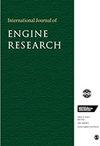使用柴油先导点火的氨燃料发动机:实现超高氨替代的方法
IF 2.1
4区 工程技术
Q2 ENGINEERING, MECHANICAL
引用次数: 0
摘要
氨是一种富氢零碳燃料,是工业和交通领域实现能源脱碳的最有前途的方法之一。高效运行和排放控制一直是开发氨能占比高的发动机的主要障碍。在本研究中,研究了柴油先导点火的氨燃料发动机的燃烧和排放情况,目标是在可接受的热效率下实现超高氨替代。在中间负荷时,首先将氨的能量份额从 30% 提高到 90%,然后通过柴油分注引发氨燃烧。研究发现,氨的能量份额增加后,指示热效率从 48.3% 降至 38.9%,同时未燃烧氨排放较高。随着氨替代率的增加,氮氧化物排放出现了一个转折点,这表明氮氧化物排放从热主导型过渡到了燃料主导型。然后,通过提前主喷射时间、改变预喷射量和两次喷射之间的间隔,优化了柴油先导喷射策略。优化后的柴油喷射控制了点火时间和燃烧过程,从而提高了高氨能量份额下的热效率和排放。最终可实现 95% 的超高氨能份额,热效率为 40.2%。此外,随着发动机负荷的增加,氨能份额为 80% 时的发动机热效率可提高到 44.2%。本文章由计算机程序翻译,如有差异,请以英文原文为准。
Ammonia fueled engine with diesel pilot ignition: Approach to achieve ultra-high ammonia substitution
Ammonia is a hydrogen-rich zero-carbon fuel, and is one of the most promising approaches to realize energy decarbonization in the fields of industry and transportation. Efficient operation and emissions control have been the primary obstacle to develop engines with high ammonia energy share. In this study, the combustion and emissions of an ammonia-fueled engine with diesel pilot ignition are investigated, and the target is to achieve ultra-high ammonia substitution with acceptable thermal efficiency. The ammonia energy share is first increased from 30% to 90% at an intermediate load, with a split diesel injection triggering ammonia combustion. It found that the increased ammonia energy share reduces the indicated thermal efficiency from 48.3% to 38.9% with high unburned ammonia emissions. The NOx emissions exhibit a turning point with increased ammonia substitution, which indicates that the NOx emissions transition from the thermal-dominated to the fuel-dominated regime. The diesel pilot injection strategy is then optimized, by advancing the main injection timing and changing the pre-injection amount and the interval between two injection events. Optimized diesel injection controls the ignition timing and combustion process, thereby improving thermal efficiency and emissions at high ammonia energy shares. An ultra-high ammonia energy share of 95% could be finally achieved, and the thermal efficiency is 40.2%. It is also noted that as engine load increases, engine thermal efficiency at an ammonia energy share of 80% could be elevated to 44.2%.
求助全文
通过发布文献求助,成功后即可免费获取论文全文。
去求助
来源期刊

International Journal of Engine Research
工程技术-工程:机械
CiteScore
6.50
自引率
16.00%
发文量
130
审稿时长
>12 weeks
期刊介绍:
The International Journal of Engine Research publishes high quality papers on experimental and analytical studies of engine technology.
 求助内容:
求助内容: 应助结果提醒方式:
应助结果提醒方式:


